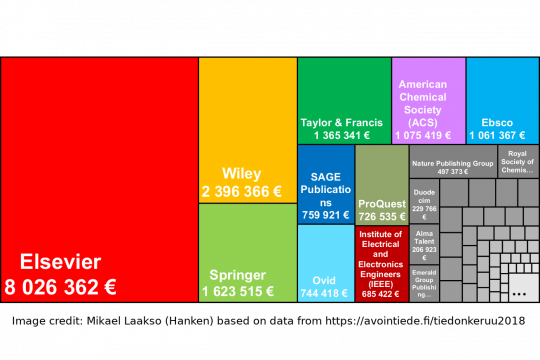The battle between the big publishers and the scientific community

I participated in last week's Townhall discussion Mikä on avoimen tiedon hinta? ("What's the price to access knowledge?"), which was precipitated by the recent discontinuation of Finnish universities' access to journals published by the Tyler & Francis group. Mikael Laakso introduced the audience to the open access issue and the problems of rising prices, and Arja Tuuliniemi reported about the ongoing negotiations with Tyler & Francis and the Wiley group.
While publishers like to portrait themselves as the researcher's friend and ally, fact is that most of the scientific publishing industry is owned by big multinational stock market-listed corporations, which primarily answer to their share holders and researchers needs play a secondary role in the best case. While one would think that electronic publishing is driving down the prices of publishing and accessing published material, the reality shows exactly the opposite.
In the current situation, where many Finnish universities are struggling with shrinking budgets, these millions of Euros could be spend better and the FinElib consortium is constantly trying to negotiate fair deals with publishing giants like Elsevier, Springer, Tyler & Francis, Wiley and SAGE. If the negotiations do not yield results before the old agreements expire, Finnish universities are sometimes cut of from access to some journals. This has happened now again (after a similar crisis in 2016). At the beginning of February this year journals published by the Taylor & Francis group have been inaccessible for Finnish researchers.
Plans S (i.e. the initiative of the European Research Council to mandate open access for all state-funded research by 2020) is certainly strengthening the negotiation position of the FinElib consortium, because all European customers are essentially lining up their requests according to the Plan S requirements. However, it is still unclear how Plan S will affect smaller, not-for-profit publishers like scientific societies (https://scholarlykitchen.sspnet.org/2018/12/06/why-society-and-not-for-p...).
My personal opinion is that there is no reason to panic. A similar shutdown of Elsevier access happened at the beginning of this year (2019) at all Max-Planck-Institutes and and seems to be tolerated by scientists quite well. Even though I might not be able to instantly access all content, this situation should be rather viewed as an opportunity. You can still access all the content that you need (perhaps with extremely rare exceptions).
- If you have lost access to a newer article, you can likely get is very easily straight from the author. it might take time, but my success rate is fairly high. There is hardly any scientist on this planet that is unwilling to share his research with you! His or her funding likely depends on dissemination. Just contact any author of the publication directly asking for an e-reprint. The first author(s) typically cares most and is most likely to respond to your request. The last author does also care, but typically receives so many emails that yours will sink so quickly to the bottom of the email list, that (s)he'll never see it.
Such a e-reprint request is handled automatically by platforms like ResearchGate and you probably want to have an account there (notwithstanding the controversy behind ResearchGate's intentions). - There are services that help you finding paywalled articles, e.g. the chrome plug-in Unpaywall and the web service Open access Button. I have not used them much, but give it a try! Google Scholar shows links to full text versions on the right hand side of article search results or when you click on the article title on a specific scholar's page. When I checked my own publications, I was happy to see that all of them are available without payment from one place or the other.
- If you have lost access to older articles, maybe you want to visit your library. Physically visiting the library used to be a scientist's daily exercise in the pre-e-publishing era, but libraries (mostly) have not thrown away these old issues, but only relocated them to less accessible storage spaces.
- Science is an international effort and most of us have scientist friends in other countries. I am pretty sure that one of them has still access to that journal. Just ask! And if you don't have a scientist friend, can simply find one on twitter who will send you the PDF. Tweet the article title (and perhaps the first author and the journal name) with the hashtag #icanhazpdf. Some people report significant success using this method!
- There are of course other methods that are legally questionable like Scihub (http://sci-hub.tw) or Genesis (http://libgen.io). Knowledge apparently wants to be free.
When you are chasing a nonfree article, you may ask yourself: Why on earth did these scientists publish in the first place in a journal that is behind a paywall? In some scientific disciplines, many of the good journals are not open source... While this is the old chicken-and-egg problem, publishing behind paywalls includes the risk of not being read. It is always touted that open access articles are more often cited than articles behind paywalls, but I still believe that journal reputation (i.e. the dreaded Impact Factor) is more important than being open, and open trumps closed only when the IF is comparable. If you have the possibility to selectively choose whom to cite (e.g. when writing a review), you would always opt for the open publication unless there were very obvious reasons not to do so and the same policy makes sense as well for publishing.



